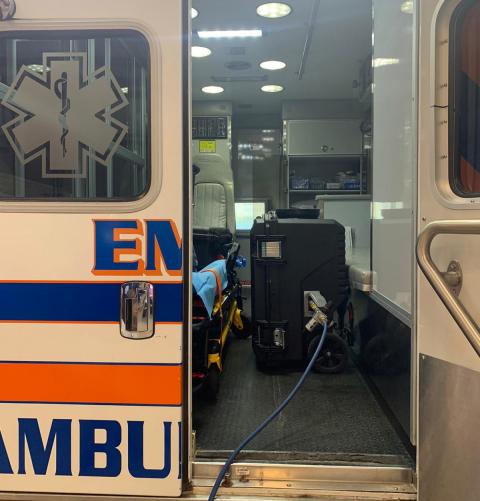Technology Impact
Technology Impact
Innovations solving national problems
Innovations solving national problems
Micro Aerosol Disinfecting System Aides in Battle Against Coronavirus

First responders are on the frontline in the battle against COVID-19, often exposing themselves, equipment, and vehicles to the deadly virus. The Florida State Firefighters Association (FSFA) has added a new disinfection technology developed at PNNL in their effort to control and mitigate the ongoing spread of the virus. The technology, known as Paerosol, was licensed to a South Carolina company called NanoPure in 2018.
Paerosol converts salt water into a powerful, micro-aerosol disinfectant that kills 99.999% of bacteria, viruses, and spores—including the COVID-19 virus. Recent testing conducted by Mako Medical Laboratories in North Carolina has provided preliminary results demonstrating Paerosol’s effectiveness at eliminating the COVID-19 viral particles.
So far, the FSFA has deployed multiple response units in the state of Florida and has disinfected dozens of fire stations, restaurants, businesses, hospitals, schools, and first response vehicles. According to the FSFA, Paerosol is simple to use, cost-effective, and requires no technical training, no site preparation, and no clean up.
A Powerful, Organic, Liquid Disinfectant that Removes 99.999% of Viruses
The technology platform consists of a powerful, organic liquid disinfectant combined with a patented, high-volume micro-aerosol generator. The liquid disinfectant is produced by dissolving ordinary table salt in water and passing an electric current through it to create what is known as an electrochemically activated solution (EAS). This salt-water-based EAS disinfectant has exceptionally strong cleaning and sanitizing properties, yet is safe, non-toxic, and non-corrosive.
Using the Paerosol technology, the liquid disinfectant is converted into a dry, micro-aerosol fog, which quickly diffuses throughout a room eliminating pathogens in the air and on surfaces. Paerosol removes 99.999% of any bacteria, viruses, and mold spores wherever they may exist, such as small crevices and hard-to-reach spots, carpets and fabrics, ventilation systems, and underneath furniture. The micro-aerosol contains highly reactive oxidative species, under 1 micron in size, which search out and destroy microbes within minutes to a couple hours, depending on the pathogen load. The tiny-sized particles remain active for extended periods of time, which enables them to thoroughly clean the air and surfaces.
From Laboratory to Marketplace
PNNL initially developed a prototype of the Paerosol technology through a now-concluded Department of Energy program. The technology was further developed with internal PNNL funding and support from the Defense Threat Reduction Agency. Since being licensed, NanoPure has sold hundreds of units and is seeking approval from the Environmental Protection Agency to sell and ship the salt solution directly to customers.
"This relationship continues to be an extremely valuable asset for our company. PNNL has provided technical guidance, data, resources, funded research opportunities, and even suggestions for complimentary intellectual property, all of which has proven to be extremely helpful to the growth of our organization.” says Scott Alderson, president of NanoPure.
Undoubtedly, the technology will continue to be put to use. Alderson says the FSFA has reached out to other fire department agencies across various states to expand the services model nationwide. The FSFA also plans to begin disinfecting personal protective equipment, such as masks, as well as food processing facilities and transportation systems, such as subways, buses, and airplanes, according to Alderson.